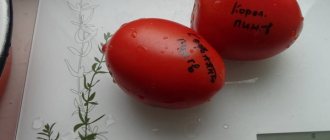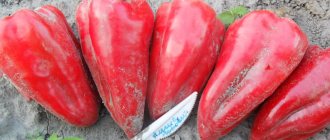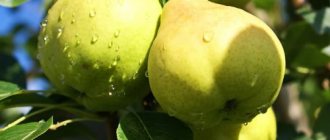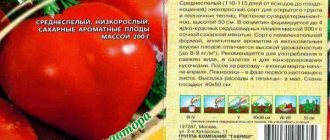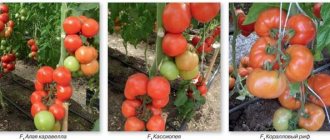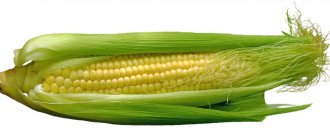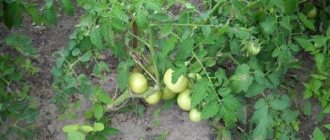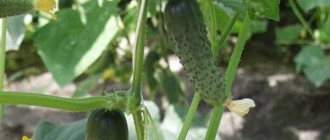Those who do not like too large or small tomatoes will like the Moscow Stars hybrid. Its fruits are medium in size and have a classic bright red color for tomatoes. Those who plant this hybrid are guaranteed a bountiful harvest.
| Height | Landing location | Ripening time | Fruit color | Fruit size | Origin | Fruit shape |
| short | Greenhouse, Open ground | Ultra early | Reds | Average | Hybrid | Round |
Description and characteristics of the variety
Moscow stars f1 is an ultra-early hybrid for open ground and greenhouses, ripening within 75 days after germination. It has a compact, low-growing bush. The height of the plant is no more than 60 cm. The bush is of a determinant type - the main shoot and any of the stepsons independently stop growing, reaching a length of 45-60 cm.
The fruits are bright scarlet, spherical, with dense pulp and durable skin. The weight of the tomato is 100-110 g. The berries are collected on complex clusters, more than 10 pieces are tied on each.
Tomatoes accumulate a lot of sugar. The variety is suitable for fresh eating, whole canning and processing into purees, juices, and ketchups.
Pests and diseases
F1 hybrids are resistant to major nightshade diseases and Moscow Star tomatoes are no exception. To prevent late blight, root rot and gray rot, it is recommended to spill the soil with disinfecting solutions before planting seedlings. The soil needs to be loosened at least once a week ; in dry weather it is better to mulch it with peat, straw or sunflower seed husks. When leaves wilt, spraying with copper-containing preparations helps. Grown tomatoes should be protected from slugs, aphids and other garden pests. Having discovered insects and their larvae, you can spray the plantings with ammonia diluted in water. Colorado beetles and slugs are removed from plants by hand.
Moscow Stars tomatoes are an excellent choice for experienced and novice gardeners. If you follow the rules of watering and timely application of fertilizers, this hybrid will never disappoint. The best results are obtained by growing in a greenhouse or under film; you can experiment by planting compact bushes in flowerpots and pots.
| Mid-early | Super early | Mid-season |
| Ivanovich | Moscow stars | Pink Elephant |
| Timofey | Debut | Raspberry Onslaught |
| Black truffle | Leopold | Orange |
| Rosaliza | President 2 | Bull forehead |
| Sugar giant | Pickling miracle | Strawberry dessert |
| Orange giant | Pink Impression | Snow fairy tale |
| One hundred pounds | Alpha | Yellow ball |
Features of cultivation and storage
Moscow f1 stars are grown in open ground without staking or pinching, planting 5 plants per square meter according to a 30 by 40 cm pattern. In a greenhouse, it is better to tie tomatoes, but the load cannot be increased. 5-6 plants per standard unit of area allow you to get maximum yield and avoid problems associated with thickening.
Tomato Moscow Stars is watered twice a week with warm water, settled in a barrel. After watering, be sure to loosen the soil and remove weeds.
Fruits can be harvested at technological or full ripeness. Green tomatoes ripen quickly at room temperature.
Landing
In mid-latitudes, seeds begin to be sown for seedlings from mid-March to early April, or 60-65 days before transplanting to the site. Pre-treatment of the seed is not necessary, since the manufacturer already treats it with fungicides.
The soil for seedlings is selected to be neutral in acidity (pH no higher than 6.5), loose, light, but nutritious. There is a mixture for tomatoes and peppers in stores. You can also prepare an organic substrate:
- 3 kg of soil from the garden;
- 3 kg of peat;
- 3 kg of humus;
- 1 kg of sand;
- 1 cup wood ash;
- 2 tsp superphosphate.
Everything is mixed well, calcined at a temperature of +110 degrees or spilled with a fungicide solution to destroy viruses and parasite larvae. After 2-3 days, new beneficial microflora will develop in the substrate, and the seeds can be planted. The rules are:
- You need to sow to a depth of 1-1.5 cm.
- The grooves are spaced 3 cm apart.
- The sown seeds are sprayed with water from a spray bottle, and the boxes are covered with film.
- Until germination, keep warm and periodically lift the film for ventilation.
- When the sprouts appear, for the first three days the temperature is reduced to +16.
- Further regime +18-22.
- You can dive after the appearance of the first true leaf.
- Feed the seedlings 1-2 times.
They are placed on the bed according to a 30 by 50 cm pattern.
It is not recommended to plant tomatoes on the ground after other nightshades. It will be possible to plant them there only after 3-4 years of growing other crops in this place.
Characteristics of Surprise tomatoes
The characteristics of all varieties of this species are similar and have several points.
- Surprise tomato varieties are indeterminate species.
- Cultivation in greenhouses is recommended.
- For these varieties, it is a prerequisite to remove the stepsons and pinch the growing point.
- As they grow, it is necessary to fix the stems on trellises or supports.
- These are tall bushes, reaching 2m in height.
- Plants are formed, most often, into one stem.
- The fruits of each variety are round, flattened at the poles and evenly ribbed.
- The fruits can be consumed fresh or processed.
- Surprise tomatoes are resistant to viruses and diseases.
The color of the fruit, depending on the variety, can be red, bright yellow, pink and crimson. All the fruits in the cluster ripen at the same time, which makes them easier to collect. Between the racemes on the stem there may be about 4 internodes with leaves
Andreevsky Surprise
Reviews from experienced farmers about the Andreevsky Surprise tomato recommend growing this variety indoors. In the conditions of Siberia, where there are strong gusts of wind, staking plants in open ground is fraught with bad consequences. You can not only witness the breakdown of some bushes, but also lose the entire fruiting area of the plants. The greenhouse must be up to 2 m high in order for the plants to develop and bear fruit normally.
At the same time, the yield remains high, as for the northern regions, within 8 kg per 1 sq.m. It is necessary to feed them, as well as water them with warm water.
Altai Surprise
The variety is resistant to cool weather and lack of light. This makes it an ideal tomato for growing in Altai meadows, in open ground
It is one of those species that requires minimal attention
The plant needs timely watering
Agricultural technology of the Altai Surprise variety consists of the following points:
- timely watering;
- weeding and loosening the soil;
- treatments against diseases and pests;
- fertilizers as needed, but at least 3 times during cultivation.
The official description states that the fruits on different plants do not ripen at the same time, so they must be collected constantly, as soon as they color. The color of ripe fruits is red, crimson or pink.
Surprise Yellow
This means that about 120 days pass from the appearance of the first shoots to the harvest. The plant is formed into 2 stems and, as it grows, all stepsons are removed.
The fruits are bright yellow. Their shape is flattened and round. Ribbing is observed from the stalk to the middle of the fruit. The weight of tomatoes ranges from 200g to 350g. You can eat them fresh whole, sliced in green salads with other vegetables and herbs, canned and in the form of juices.
Grandmother's Gift (Surprise)
Belongs to mid-late varieties of indeterminate type. It is recommended to form it into 1 stem, but reviews from gardeners say that two stems bear more fruit. At the same time, the viability of the plant is preserved, and its yield does not decrease.
The fruits are large, slightly ribbed, red. Each weight is about 250 grams. Very juicy and tasty, which, in general, is not typical for hybrids. When broken, they have sugary crystals, and a light and pleasant aroma is felt from it.
Room Surprise
From the name of the variety it is clear that it is designed for growing on window sills and balconies. In these conditions, when the volume of soil does not allow the root system to develop freely, it feels excellent. These varieties can be used as perennial plants that can produce crops all year round. The lack of light leads to the fact that the internodes become shorter, and the bush itself takes on the shape of a ball, covering the entire space of the window sill or balcony box.
Its fruits are plum-shaped, red in color and have excellent taste. It is also possible to grow in open ground conditions. Then the bush will be taller, not up to 50cm, and the yield will increase slightly.
Each of these varieties has strong stems that are evenly leafy. The leaves are not large, dark green. At the 8th leaf level, clusters of flowers are formed, which, after pollination, set up to 10 fruits.
Characteristics and description of tomato variety Moscow ultra-early ripening
In spring, people lack vitamins and crave fresh fruits and vegetables. That’s why many people try to plant tomatoes that will produce a harvest earlier than others, like the Ultra Early Ripe tomato variety. In the article we will look at its advantages and give characteristics and descriptions.
- Description and characteristics of tomato Ultra early ripening F1
- Advantages and disadvantages of the variety
- Which regions are best to grow in?
- Soil requirements for planting
- Sowing rules
- Transplanting tomatoes into open ground
- Caring for the variety after transplantation
- Diseases and their prevention
- Harvesting and storage rules
Description and characteristics of tomato Ultra early ripening F1
The plant is characterized as low bushes with small round-shaped fruits that ripen within 70 days after germination.
The average weight of one tomato is 100 grams. It has a dense, glossy red skin. Tomatoes grow in clusters, about eight pieces each, on strong, thick stems. The height of the bushes according to established standards is 50 centimeters.
The harvested crop can be consumed raw, or can be used for preparing hot dishes and canned. The product is not meaty, but juicy, therefore it is also suitable for making tomato paste and juices.
The average weight of Ultra-early fruits is 100 grams
Advantages and disadvantages of the variety
Despite the fact that this is a relatively new variety, gardeners in the country grow it on their plots both in the Urals and in the Moscow region with pleasure.
Characteristics that can be called advantages include:
- Frost resistance.
- Low maintenance requirements.
- Resistance to tomato diseases.
- Early harvest.
- Suitable for blanks.
- They have a pleasant taste.
- Well preserved and transported.
- No need to tie it up.
- Withstands temperature changes and heat.
- Uniform ripening.
The main advantages of the variety are early harvest and disease resistance.
Which regions are best to grow in?
The variety was bred in the twenty-first century in Siberia. Its cultivation is possible in all regions of the country, because these tomatoes are resistant to various temperatures and many common diseases.
The ultra-early ripening species grows equally well in a greenhouse and in open ground.
Soil requirements for planting
Tomatoes grown in slightly acidic soil perform better. Loamy and sandy loam options are also suitable for them. The soil prepared for seedlings must be fertilized.
The beds are created in places where the winds are rare and not strong. You should consider what vegetables will grow nearby. Good neighbors are carrots, cabbage, onions or zucchini, and these tomatoes should be planted away from other members of the nightshade family. It is not recommended to grow a crop for more than three years in 1st place.
The varietal early ripening variety grows both in the shade and in the sun. In the second case, the process of fruit ripening occurs faster.
Sowing rules
Tomato seeds Ultra early ripening
Seeds can be sown immediately in a greenhouse, but more often the planting material is prepared in advance at home. In pre-prepared containers with fresh soil, the tomato seed is deepened by 2-3 centimeters.
The containers are covered with film to retain the heat necessary for germination. When the sprouts have two or three leaves, they are planted in separate pots or in greenhouse beds.
Transplanting tomatoes into open ground
A suitable temperature regime is defined as maintaining +15 degrees and the absence of night frosts. Ten days before this procedure, gardeners advise starting the hardening process.
Fertilizer is applied to the dug holes before planting. Planted young bushes are watered with warm water. It is recommended to install special arcs over the bed so that when the temperature drops, it can be insulated with a transparent film. Early ripening tomatoes can be moved to greenhouse conditions as early as April at a temperature of 22-24 degrees.
The best varieties of tomatoes with pink fruits: photos and descriptions
Tomato varieties with pink fruits are very popular among vegetable growers. However, they have their supporters and opponents. By the way, in Europe such tomatoes are described as a breeding defect. But in Japan, on the contrary, only pink large-fruited tomatoes and cherry tomatoes are recognized. The pink-fruited tomato is held in high esteem in the Middle East; the market for pink-fruited tomatoes has also long been famous in the Asian part of Russia - in Altai and the Primorsky Territory. So how do they compare favorably and where do they fall short?
First of all, pink tomatoes taste great.
As you can see in the photo, pink varieties of tomatoes have very delicate skin and very juicy pulp:
The delicacy of the taste of pink-fruited tomatoes is created by a harmonious combination of sugars and acids. Secondly, pink tomatoes, along with yellow-fruited ones, are given primacy in nutritional value and healthfulness: they contain twice as much provitamin A as regular tomatoes. They are recommended for children's and dietary nutrition. These tomatoes are ideal for fresh consumption and salads. They are also suitable for pickling, but not when fully ripe.
Pink-fruited tomatoes are not only delicate in taste, but also require gentle handling, but they can be grown in film greenhouses, under temporary film covers, and even in open ground. The main thing is to avoid large changes in air humidity and not to overdry the soil in order to avoid cracking of the fruits. Otherwise, the same requirements should be observed as for other tomatoes grown in film greenhouses.
There are still few varieties and hybrids of pink-fruited tomatoes, but breeders are already actively working on creating pink-fruited hybrids with large fruits and comprehensive disease resistance. And the first of them is the breeding and seed hybrid F1 Rosamarin, which is already well known to gardeners. This tomato has particularly tender flesh. With good agricultural technology, the fruits of the best varieties of pink tomatoes reach quite large sizes and weigh 400 g. F1 Rosamarin is intended for growing in greenhouses and is formed like a regular tall tomato. The hybrid is genetically resistant to tobacco mosaic virus, cladosporium and fusarium. Productivity depending on growing conditions is up to 6-8 kg per plant.
These photos illustrate the description of the pink tomato variety Rosemary:
